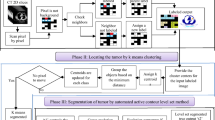Abstract
Purpose
This paper proposes a new image segmentation technique for identifying nasopharyngeal tumor regions in CT images. The technique is modified from the seeded region growing (SRG) approach that is simple but sensitive to image intensity of the initial seed.
Methods
CT images of patients with nasopharyngeal carcinoma (NPC) were collected from Ramathibodi hospital, Thailand. Tumor regions in the images were separately drawn by three experienced radiologists. The images are used as standard ground truth for performance evaluation. From the ground truth images, common sites of nasopharyngeal tumor regions are different from head to neck. Before the segmentation, each CT image is localized: above supraorbital foramen (Group I), below oropharynx (Group III), or between these parts (Group II). Representatives of the CT images in each part are separately generated based on the Self-Organizing Map (SOM) technique. The representative images contain invariant features of similar NPC images. For a given CT slice, a possible tumor region can be approximately determined from the best matching representative image. Mode intensity within this region is identified and used in the SRG technique.
Results
From 6,606 CT images of 31 NPC patients, 578 images contained the tumors. Because NPC images above the supraorbital foremen were insufficient for study (6 images from 1 subject), they were excluded from the analysis. The CT images with inconsistent standard ground truth images, metastasis cases, and bone invasion were also disregarded. Finally, 245 CT images were taken into account. The segmented results showed that the proposed technique was efficient for nasopharyngeal tumor region identification. For two seed generation, average corresponding ratios (CRs) were 0.67 and 0.69 for Group II and Group III, correspondingly. Average PMs were 78.17 and 82.47%, respectively. The results were compared with that of the traditional SRG approach. The segmentation performances of the proposed technique were obviously superior to the other one. This is because possible tumor regions are accurately determined. Mode intensity, which is used in place of the seed pixel intensity, is less sensitive to the initial seed location. Searching nearby tumor pixels is more efficient than the traditional technique.
Conclusion
A modified SRG technique based on the SOM approach is presented in this paper. Initially, a possible tumor region in a CT image of interest is approximately localized. Mode intensity within this region is determined and used in place of the seed pixel intensity. The tumor region is then searched and subsequently grown. The experimental results showed that the proposed technique is efficient and superior to the traditional SRG approach.
Similar content being viewed by others
References
Peter B, Bernard L (2008) World Cancer Report 2008. In: publication of international agency for research on cancer, WHO, pp 12–39
Lertsanguansinchai P, Thitathan S, Rojpornpradit P, Rajatapiti P (1992) Nasopharyngeal carcinoma (NPC): a retrospective review of 184 patients treated with radiotherapy. Chula Med J 36(11): 829–837
Ozer E, Joshua W (2008) Transoral robotic nasopharyngectomy: a novel approach for nasopharyngeal lesions. Laryngoscope 118(9): 1613–1616
Yamashita S, Kondo M, Hashimoto S (1985) Conversion of T-stages of nasopharyngeal carcinoma by computed tomography. Int J Radiat Oncol Biol Phys 11: 1017–1021
Chung NN, Ting LL, Hsu WC et al (2004) Impact of magnetic resonance imaging versus CT on nasopharyngeal carcinoma: primary tumor target delineation for radiotherapy. Head Neck 26: 241–246
Lin JC, Jan JS, Hsu CY et al (2003) Phase III study of concurrent chemoradiotherapy versus radiotherapy alone for advanced nasopharyngeal carcinoma: positive effect on overall and progression-free survival. J Clin Oncol 21(4): 631–637
Sankur B, Sezgin M (2004) . J Elect Imaging 13(1): 146–165
Otsu N (1979) A threshold selection method from gray-level histogram. IEEE Trans Syst Man Cybern 9: 62–66
Adams R, Bischof L (1994) Seeded Region Growing. IEEE Trans Pattern Anal Mach Intell 16(6): 641–647
Lee FK, Yeung DK, King AD (2005) Segmentation of nasopharyngeal carcinoma (NPC) lesion in MR images. Int J Radiat Oncol Biol Phys 61(2): 608–620
Zhou J, Chan KL, Xu P (2006) Nasopharyngeal carcinoma lesion segmentation from MR images by support vector machine. In: IEEE international symposium on biomedical imaging: nano to macro, vol 3, pp 1364–1367
Furey TS, Cristianini N, Duffy N et al (2000) Support vector machine classification and validation of cancer tissue samples using microarray expression data. Bioinformatics 16(10): 906–914
Ping-Lin C, Wei-Guang T (2007) Exploiting the Self-Organizing Map for medical image segmentation. In: Proceedings of IEEE international symposium on computer-based medical system, vol 20, pp 281–288
Murugavalli S, Rajamani V (2006) A high speed parallel fuzzy C-Mean algorithm for brain tumor segmentation. Bioinfo Med Eng 06(1): 29–34
Murugavalli S, Rajamani V (2007) An improved implementation of brain tumor detection using segmentation based on neuro fuzzy technique. J Comp Sci 3(11): 841–846
Pardo XM, Carreira MJ, Mosquera A et al (2001) A snake for CT image segmentation integrating region and edge information. Imag Vis Comput 19(7): 461–475
Suri JS, Liu L, Singh S (2002) Shape recovery algorithms using levels sets in 2-D/3-D Medical Imagery: a state-of-the-art review. IEEE Trans Info Techno Biomed 6(1): 8–28
Dubey RB, Hanmandlu M, Gupta SK (2009) Semi-automatic segmentation of MRI brain tumor. Int J Graph Vis Image Process 9(4): 33–40
Studholme C, Little JA, Penny GP (1996) Automated multimodality registration using the full affine transformation: application to MR and CT guided skull base surgery. In: visualization in biomedical computing. Springer-Verlag publishing, Berlin, Germany, pp 601–606
Kohonen T (1982) Self-organized formation of topologically correct feature maps. Biol Cybern 43: 59–69
Zhang J, Liu Q, Chen Z (2005) A medical image segmentation method based on SOM and wavelet transforms. J Commun Comput 2(5): 46–50
Jiang Y, Chen KJ, Zhou ZH (2003) SOM based image segmentation. In: Proceedings of rough sets, fuzzy sets, data mining, and granular computing. LNAI 2639(572):640–643
Author information
Authors and Affiliations
Corresponding author
Rights and permissions
About this article
Cite this article
Chanapai, W., Bhongmakapat, T., Tuntiyatorn, L. et al. Nasopharyngeal carcinoma segmentation using a region growing technique. Int J CARS 7, 413–422 (2012). https://doi.org/10.1007/s11548-011-0629-6
Received:
Accepted:
Published:
Issue Date:
DOI: https://doi.org/10.1007/s11548-011-0629-6




